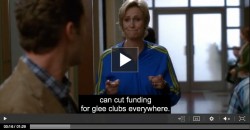On Friday, January 13, 2012 the Federal Communications Commission (FCC) released rules governing the closed captioning requirements for video programming delivered using Internet protocol (IP). This Report & Order also includes rules on the closed captioning capabilities of certain apparatus on which consumers view video programming. These rules were issued pursuant to the 21st Century Communications and Video Accessibility Act of 2010 (CVAA) and explain how the FCC will apply the CVAA sections related to IP captioning.

“We are thrilled with this tremendous step forward in making online programming accessible for millions of deaf and hard of hearing people. Access to online videos is very important to our community. Our efforts to make the Internet more accessible are far from finished. We will continue to advocate for full access to the online world,” said NAD President Bobbie Beth Scoggins.
The new rules will make sure that all new content shown on TV and then on the Internet is captioned, including live content. There is a schedule of deadlines for when coverage of new content will begin. The CVAA mandates the following deadlines following publication in the Federal Register:
6 months: Prerecorded programming that is not edited for Internet distribution.
12 months: Live and near live programming that was recorded within 24 hours of broadcast on television.
18 months: Prerecorded programming that is edited for Internet distribution.
24 months: Archival programming
The rules require that programs re-aired on TV, such as Gone with the Wind, must be captioned when shown online. This means that if a website has a old program that is not captioned, which is re-aired on TV, then the website will have to add captions to the program.
The rules are the culmination of years of hard work by the NAD and other consumer organizations to gain access to online content. The NAD was a key organization that worked to pass the CVAA in Congress. The law was signed by President Obama in October 2010. The IP captioning rules are just one part of the CVAA; however, a very important part for deaf and hard of hearing people who want to enjoy programming online just like other Americans.
Following the passage of the CVAA, the Video Programming Access Advisory Committee (VPAAC) brought together both consumers and members of the industry to craft recommendations to the FCC on making video programming more accessible. The NAD advocated for broad IP captioning rules which would cover the most amount of online content and in the shortest possible time. We continue to be very involved with the VPAAC in proposing rules on the closed caption button for devices and software.
The NAD co-led the Consumer Groups comments and reply comments last fall in response to the proposed FCC rules. Following the comment period, we met with different groups at the FCC including the FCC Commissioners offices. The NAD and other consumer groups pushed for coverage of all online content that has been shown on television and later on the Internet. We are pleased with the rules; however, there are some gaps in coverage.
The NAD is most concerned about the coverage of segments of programs taken from TV and shown online. The Senate report for the CVAA explains that the CVAA applied only to full-length programs and not video clips and outtakes. We believe that this language intended to exempt video clips that are shown on TV and are not required to be captioned on TV – such as advertisements. Representative Markey and Senator Pryor, the authors of the CVAA, sent a letter to the FCC supporting our arguments, explaining that the law intended to cover segments of programs. The FCC disagreed with us and decided that the exemption for video clips applied to segments taken from television. Under this exemption, a five minute news report from CNN and placed at http://www.cnn.com would not be covered under the CVAA. The FCC however did clarify that if “substantially all” of the program is placed online, though broken up into pieces, then they are covered. We are disappointed in this huge gap in coverage and will reach out to media companies asking them to voluntarily caption video segments placed online.
The rules also require that all physical devices designed to receive and play back video programming, including smartphones, tablets, personal computers, and television set-top boxes must support captions. This will solve long standing concerns from members of the community that some set-top boxes such as Blu-ray players do not support captions. The FCC also requires that the quality of captions shown online must be at least the same quality as the captions shown on TV.
To see the full FCC report, visit:
http://transition.fcc.gov/Daily_Releases/Daily_Business/2012/db0113/FCC-12-9A1.pdf
